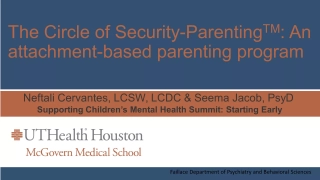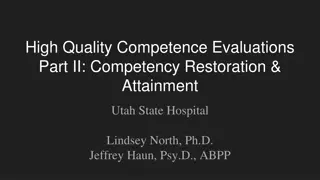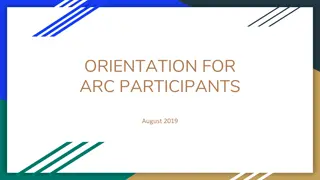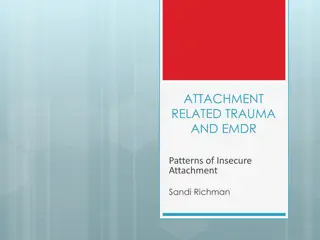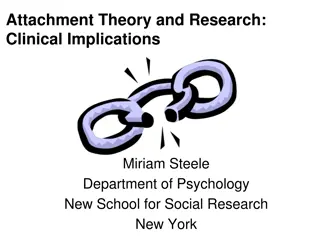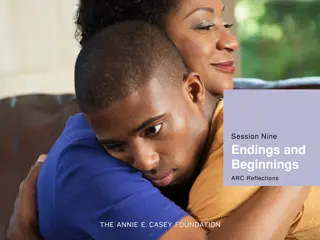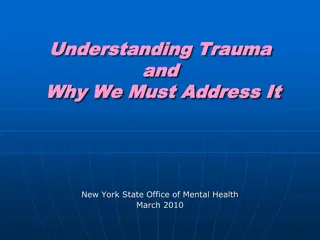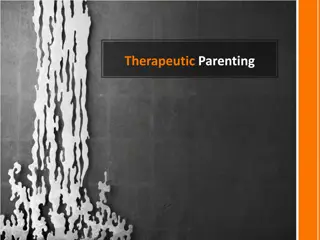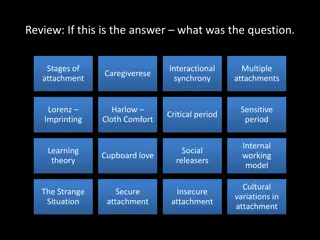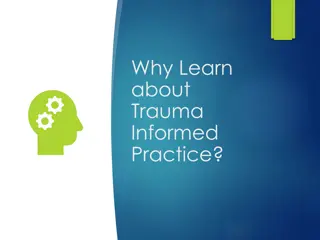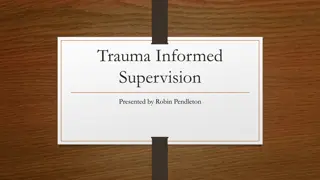Understanding ARC: Attachment, Regulation, and Competency in Trauma Care
Explore the world of ARC (Attachment, Regulation, and Competency) in trauma care, a framework designed for working with children and teens affected by trauma. Learn about the core principles of ARC, its focus on strengthening relationships, enhancing self-regulation, and building resilience. Discover how ARC Reflections offers caregiver training to support families in creating safe and healthy environments for healing. Gain insights into the essential role of caregivers in the treatment process and how ARC empowers both youth and caregivers to navigate the complexities of trauma recovery together.
Download Presentation

Please find below an Image/Link to download the presentation.
The content on the website is provided AS IS for your information and personal use only. It may not be sold, licensed, or shared on other websites without obtaining consent from the author. Download presentation by click this link. If you encounter any issues during the download, it is possible that the publisher has removed the file from their server.
E N D
Presentation Transcript
ARC REFLECTIONS Session 1
Session 1 Welcome! Topics: Introduction to ARC And Trauma
Lets decide on some rules Start on time. Practice respect for yourself and others. Come prepared to do your part. Be a good listener. No put-downs. Make sure everyone gets a chance to contribute or speak. Accept constructive criticism gracefully. Critique ideas, not people. Stay on task. No interruptions; let people finish talking. Ask for help when you re confused about what to do. Help others when you can. Do your fair share of the work. Commit to meeting at scheduled time
What is ARC? ARC, or Attachment, Regulation and Competency, is a framework for working with children and teens who have experienced trauma. Developed by Margaret Blaustein and Kristine Kinniburgh of the Justice Resource Institute ARC builds on the resilience of children, teens and families
What is ARC? Attachment strengthening the caregiving system surrounding youth through enhancing supports, skills, and relational resources for adult caregivers Regulation cultivating youth awareness and skill in identifying, understanding, tolerating, and managing internal experience Competency identify and implement key factors associated with resilience
What is ARC Reflections? ARC Reflections an ARC-informed caregiver training curriculum for foster parents, kin and other caregivers was written by Blaustein and Kinniburgh with support and consultation from the Annie E. Casey Foundation https://www.aecf.org/work/child-welfare/child- welfare-strategy-group/arc-reflections-training- program
What does ARC look like? For Caregiver(s): One of the core goals of ARC treatment is to support families in building safe, healthy relationships Caregivers will be seen as a very important part of the treatment, and of the treatment team This is not a service for youth only but for the whole family Caregivers (kin, foster parents, chosen family) may be supported in: identifying strengths and challenges within their family system learning more about their own emotional experience as relates to their child(ren) and to parenting identifying and accessing support resources addressing the relationship between caregiver and child(ren) supporting families in learning to read each others communication strategies responding in increasingly effective ways
What does ARC look like? For youth: Attachment: learning how to function within and be a part of a functional family system Regulation: learning how to be aware of, understand, label and have tools for feelings and energy states Competency: learning important tools for reflecting on who he or she is and developing an understanding of his or her experiences The goal of ARC is traumatic experience integration The goal for IPS is system of care
What is trauma? Trauma refers to experiences that are overwhelming and may leave a person feeling helpless, vulnerable, or very frightened. There are three categories: Acute trauma. This includes frightening, one-time, time-limited events with a start and a stop, such as dog bites, car accidents or natural disasters. Chronic trauma. Children may experience ongoing, repeated patterns of terrible events, such as physical, sexual or emotional abuse, domestic violence and neglect. Complex trauma. Children may face extreme experiences beginning when they are younger than 5 years old that are brought about by people who are supposed to care for them.
What is trauma? Trauma can profoundly influence a child or teen, even when it takes place during infancy and even when he or she has no memory of what happened
What is trauma? The Body Keeps the Score by Bessel Van der Kolk, MD Adverse Childhood Experiences (ACEs) Study (cdc.gov)
What is trauma? Chronic trauma shapes nearly every aspect of a child s or teen s life Brain develops differently and other physiological effects may occur Evocative cues added (triggers) and an overactive alarm system is engaged View of self is affected Worldview is greatly influenced Experiencing complex trauma changes a person and their reactions to the world around them Develop an expectation that bad things will happen to them Have a hard time forming and maintaining relationships with people Have difficulty managing and regulating feelings and behaviors
Meet Olivia Olivia is a 5-year-old girl of mixed ethnicity. Her parents used substances (primarily heroin, alcohol and marijuana) and there was frequent violence in their relationship. The family moved four times during Olivia s first two years and was homeless once. Often Olivia s mother would leave her with friends or other relatives for brief periods. Olivia and her mother moved into a shelter when Olivia was 3 years old, but her mother returned to Olivia s father after six months. Two months later, dad was incarcerated because of a domestic violence incident and multiple intent-to-distribute charges. He was arrested in front of Olivia. Olivia was removed from her mother s custody three months later after allegations of neglect and physical abuse. In the past year, Olivia has lived in three different foster homes. She was just placed in her current home. Olivia s mother has been unable to comply with service plans requiring treatment of her diagnosed bipolar disorder and substance abuse.
Olivia What in Olivia s experience would you consider traumatic? Why? What do you think Olivia has learned about relationships? How do you think she might react to other people? What do you think Olivia has learned about herself in the past five years? How do you think Olivia got through her experience? What survival skills might she have learned?
How does trauma act? Traumatic responses are formed as a protective strategy and may have been useful in a different environment Evocative cues (triggers) can activate an alarm system response These alarm system responses make sense IF we ask the question Why? We can help family members meet their needs and feel safe in our home if we remain aware
How does trauma act? All of us develop strategies for managing the world (behavioral patterns) guided in part by our previous experiences (what we ve used in the past that has been successful) Trauma Response: Most children and teens who have experienced trauma have many behaviors that can push the buttons of those around them Our response: The more we understand where behaviors come from, the more effective our response will be
How does trauma act? Reacts to a perceived threat to safety or necessity to meet a need
How does trauma act? Being in a safe environment, even with the most well-intentioned and loving caregivers, does not mean a child or teen feels safe. Sometimes people choose familiar pain over unknown happiness They may create chaos because that feels safe These trauma responses may have worked for the youth in another environment with another caregiver(s) with different conditions. Sometimes these negative behaviors are reenforced and have proven effective However, what worked in the other environment may no longer work in the current environment
What did we learn today? Many different things may be experienced as traumatic Trauma can profoundly influence child development and worldview Trauma shapes the child s or teen s lens for self, for relationships and for perceived danger Homework: Ted talk by Nadia Burke about how ACEs effect health https://www.ted.com/talks/nadine_burke_harris_how_childhood_trauma_affect s_health_across_a_lifetime?language=en


